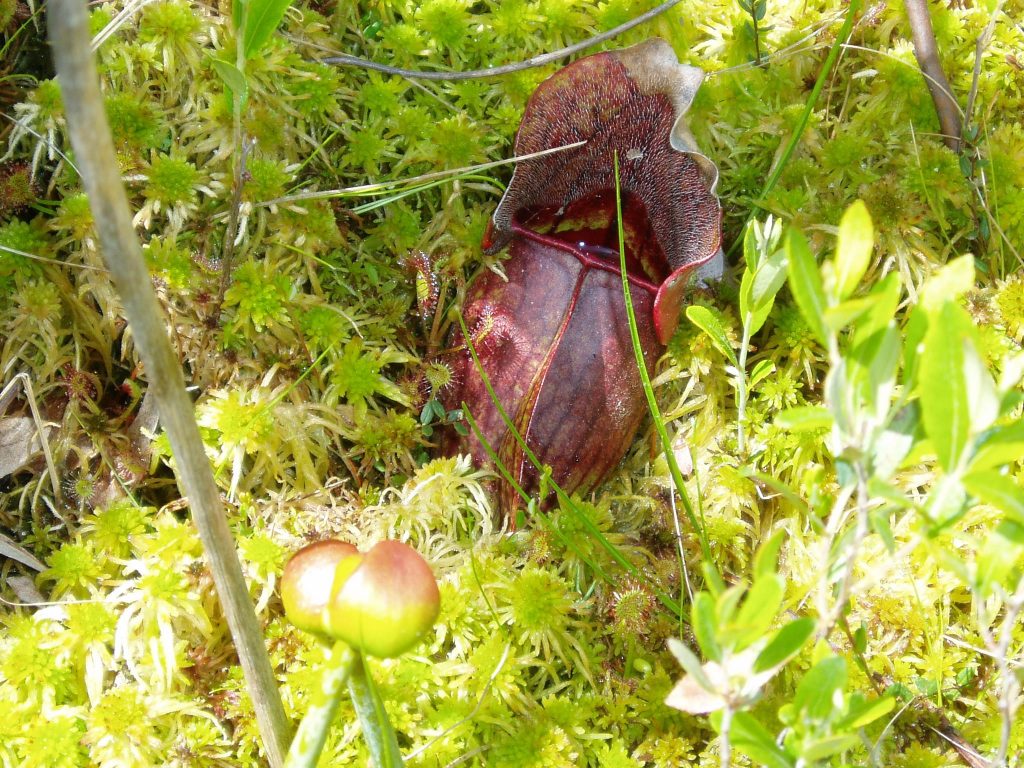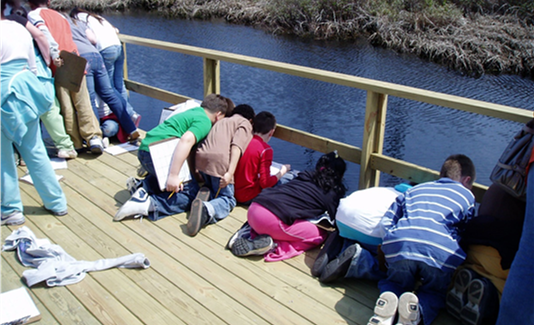Tannersville Cranberry Bog Preserve
By Roger Spotts
Environmental Education Coordinator
 Each time I enter the Tannersville Bog there is a sense of anticipation. What will the group I am leading today encounter along the trail through the rhododendrons, or over the ridge? What lies around the next bend on the boardwalk? What will swim past the floating platform on Cranberry Creek? The Tannersville Bog and the surrounding natural area is truly a wonderful outdoor laboratory that I have been exploring with groups of all types for over 30 years.
Each time I enter the Tannersville Bog there is a sense of anticipation. What will the group I am leading today encounter along the trail through the rhododendrons, or over the ridge? What lies around the next bend on the boardwalk? What will swim past the floating platform on Cranberry Creek? The Tannersville Bog and the surrounding natural area is truly a wonderful outdoor laboratory that I have been exploring with groups of all types for over 30 years.
In 1983, when I first took the job as a naturalist with the Monroe County Conservation District, the boardwalk was only 350 feet. I followed Don Miller onto the floating walkway and experienced a habitat that I had never encountered before growing up in a non-glaciated area of central Pennsylvania. Don explained the Bog’s formation, ecology, and plant life. He pointed out pitcher plants, black spruce, and more. I was hooked. Don’s passion for the unique place was evident and more than 30 years later I can understand why. Each time I visit there is something new to discover.
Over the years, the boardwalk has been lengthened, the plant community has changed slightly, but the bog has basically stayed the same. It provides a wonderful outdoor teaching area to discuss a whole range of things, from glaciers to flood control, peat formation to photosynthesis, bird migration to amphibian life cycles, and so much more.
When the Nature Conservancy first became involved with protecting this unique bog in the 1950s, I don’t think they ever imagined the impact it would have. Not only are the bog’s natural features protected, but there are over 1,000 acres in the preserve and two miles of hiking trails. Most importantly, the bog has become an invaluable educational tool. Since the early 1980s when the first section of boardwalk was completed, countless groups have visited the bog. From kindergarteners to senior citizens, garden clubs to college classes, family groups to summer camps, they have all learned about the bog and the importance of wetlands in general.
 I don’t know how many walks I have led over the past 32 years, but I will always remember some of the interesting things encountered. On a public bog walk one August evening, a young male black bear shared the trail with the group; I noticed that the group of high school students had stopped listening to my detailed description of the Bog because a bear had walked out onto the boardwalk behind me. After the bear disappeared and we continued our walk, they were even more amazed. I also remember a pair of snowshoe hares chasing each other through the rhododendrons on another public walk, oblivious to the twenty people standing there as they ran circles around the shrubs. I’ve seen otters, owls, frogs, dragonflies, and so much more. The Bog has showed its many colorful flowers as well, and on July walks sweet blueberries flourish along the boardwalk.
I don’t know how many walks I have led over the past 32 years, but I will always remember some of the interesting things encountered. On a public bog walk one August evening, a young male black bear shared the trail with the group; I noticed that the group of high school students had stopped listening to my detailed description of the Bog because a bear had walked out onto the boardwalk behind me. After the bear disappeared and we continued our walk, they were even more amazed. I also remember a pair of snowshoe hares chasing each other through the rhododendrons on another public walk, oblivious to the twenty people standing there as they ran circles around the shrubs. I’ve seen otters, owls, frogs, dragonflies, and so much more. The Bog has showed its many colorful flowers as well, and on July walks sweet blueberries flourish along the boardwalk.
People sometimes ask me if it ever gets boring leading bog walks and my answer is always no. The bog is never the same, even when I lead two walks in the same day. My favorite walk in the bog is when I take a group of fourth graders on a two-hour excursion. The excitement on their faces when they see a pitcher plant or sundew for the first time and learn about how they eat insects is priceless. The reactions produced when they squeeze the sphagnum and water comes out, or when they smell the peat moss, makes the entire experience so rewarding and so much different from what they are familiar with in today’s electronics-filled world.
I am lucky to have a job that lets me share this place with so many people.

